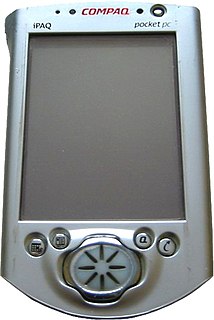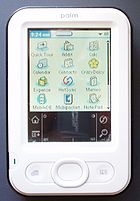
A personal digital assistant (PDA), also known as a handheld PC, is a variety mobile device which functions as a personal information manager. PDAs have been mostly displaced by the widespread adoption of highly capable smartphones, in particular those based on iOS and Android.

The Sony CLIÉ is a series of personal digital assistants running the Palm Operating System developed and marketed by Sony from 2000 to 2005. The devices introduced many new features to the PDA market, such as a jog-wheel interface, high-resolution displays, and Sony technologies like Memory Stick slots and ATRAC3 audio playback. Most models were designed and manufactured in Japan. The name is an acronym for creativity, lifestyle, innovation, emotion though formerly communication, link, information and entertainment. It was initially an attempt at a new coinage term, though it means "tool" in the Jèrriais language.

Palm OS is a discontinued mobile operating system initially developed by Palm, Inc., for personal digital assistants (PDAs) in 1996. Palm OS was designed for ease of use with a touchscreen-based graphical user interface. It is provided with a suite of basic applications for personal information management. Later versions of the OS have been extended to support smartphones. Several other licensees have manufactured devices powered by Palm OS.

A Pocket PC is a class of personal digital assistant (PDA) that runs the Windows Mobile or Windows Embedded Compact operating system that has some of the abilities of modern desktop PCs. The name was introduced by Microsoft in 2000 as a rebranding of the Palm-size PC category. Some of these devices also had integrated phone and data capabilities, which were called Pocket PC Phone Edition or simply "Smartphone".

Palm was a line of personal digital assistants (PDAs) and mobile phones developed by California-based Palm, Inc., originally called Palm Computing, Inc. Palm devices are often remembered as "the first wildly popular handheld computers," responsible for ushering in the smartphone era.
The Zire Series was Palm, Inc's "consumer-grade" brand of Personal Digital Assistant.

Casio Cassiopeia was the brand name of a PDA manufactured by Casio. It used Windows CE as the Operating system. Casio was one of the first manufacturers of PDAs, developing at the beginning small pocket-sized computers with keyboards and grayscale displays and subsequently moving to smaller units in response to customer demand.

The Tapwave Zodiac is a mobile entertainment console. Tapwave announced the system in May 2003 and began shipping in October of that same year. The Zodiac was designed to be a high-performance mobile entertainment system centered on video games, music, photos, and video for 18- to 34-year-old gamers and technology enthusiasts. By running an enhanced version of the Palm Operating System (5.2T), Zodiac also provided access to Palm's personal information management software and many other applications from the Palm developer community. The company was based in Mountain View, California.
A human interface device or HID is a type of computer device usually used by humans that takes input from humans and gives output to humans.

The Tungsten series was Palm, Inc.'s line of business-class Palm OS-based PDAs.
The Ruputer is a wristwatch computer developed in 1998 by Seiko Instruments, a subsidiary of the Seiko Group. In the US, it was later marketed as the onHand PC by Matsucom.
The Universal Connector was a standard port fitted to the bottom of many Palm PDA's from 2001 to 2004 and on units from other manufacturers that licensed Palm technology, including Garmin.

The Jornada was a line of personal digital assistants or PDAs manufactured by Hewlett-Packard. The Jornada was a broad product line that included Palm-Size PCs, Handheld PCs, and Pocket PCs. The first model was the 820, released in 1998, and the last was the 928 model in 2002 when Compaq and HP merged. The Jornada line was then succeeded by the more popular iPAQ model PDAs. All Jornada models ran Microsoft Operating Systems that were based on Windows CE.
The Palm m500 series of handheld personal digital assistants consisted of three devices: the Palm m500, Palm m505, and Palm m515. The series was a follow-up to the popular Palm V series with a similar, though slightly shorter, footprint and form factor.
Palm Desktop is a personal information manager computer program for Microsoft Windows or Mac OS/Mac OS X, and can be used alone or in combination with a Palm OS personal digital assistant.
The Sony CLIÉ PEG-SJ33 was a Palm OS based handheld "Personal Entertainment Organizer" released by Sony in 2003. It was released with a heavy multimedia focus, one of its key features being the inclusion of MP3 player software and built-in stereo sound hardware. The PEG-SJ33 has the same HiRes screen as the other low-end colour CLIÉ models. This device was later superseded by the Clie TJ Series.
Handspring, Inc. was an American electronics company founded in 1998 by the founders of Palm, Inc. after becoming dissatisfied with the company's direction under new owner 3Com. The company developed Palm OS–based Visor- and Treo-branded personal digital assistants. In 2003, the company merged with Palm, Inc.'s hardware division.
Pocket-sized computer describes the post-programmable calculator / pre-smartphone pocket-sized portable-office hardware devices that included the earlier DOS-based palmtops and subsequent Windows-CE handhelds, as well as a few other terms, primarily covering the 1980s through 2007.
The Sony Clie UX series were premium multimedia PDAs announced by Sony in July 2003, running Palm OS. These devices were advertised as being a "personal entertainment communicator", a purpose not dissimilar to the Apple iPod Touch released in 2007. Two models were released, featuring a "palm-top" clamshell design, with a landscape tilting and swiveling LCD screen.
All references below are dead links and dead pages.









